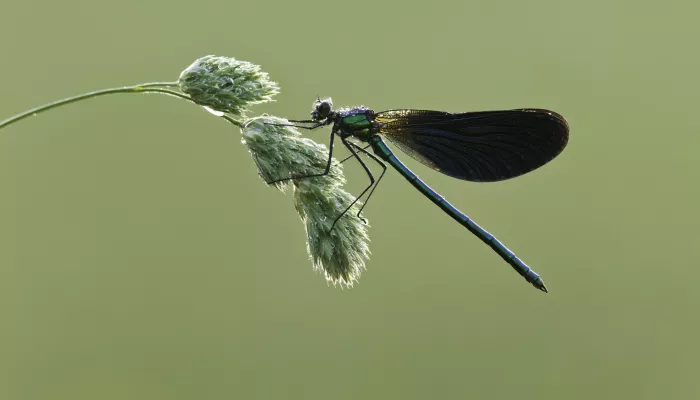Banded demoiselle
The Banded demoiselle can be seen flitting around slow-moving rivers, ponds and lakes. The males are metallic blue, with a distinctive dark band across their wings, and the females are a shiny green.

Find and learn about the many wonderful species of damselflies in Kent using our handy species guides.
The Banded demoiselle can be seen flitting around slow-moving rivers, ponds and lakes. The males are metallic blue, with a distinctive dark band across their wings, and the females are a shiny green.
The metallic-green Emerald damselfly can be seen from June to September around ponds, lakes, ditches and canals. Unlike other damselflies, it holds its wings half-open when perched.
If you have a garden pond, look out for the Large red damselfly resting at the water's edge. As the name suggests, males are bright red with a black thorax, but females may be almost entirely black.
The Azure damselfly is a pale blue, small damselfly that is commonly found around most waterbodies from May to September. Try digging a wildlife pond in your garden to attract damselflies and dragonflies.
Living up to its name the Common blue damselfly is both very common and very blue. It regularly visits gardens - try digging a wildlife-friendly pond to attract damselflies and dragonflies.
The Blue-tailed damselfly does, indeed, have a blue tail. It is one of our most common species and frequents gardens - try digging a wildlife pond to attract dragonflies and damselflies.
The Red-eyed damselfly is a small, but robust, damselfly of canals, ponds, lakes and slow-flowing rivers. As its name suggests, it has bright blood-red eyes, but a mostly black body.
Beautiful demoiselle’s are, well, beautiful! Often confused for a dragonfly, these giants of the damselfly world are hard to miss with their metallic blue and green colours.
A recent colonist to South East England, the metallic-green Willow emerald damselfly spends much of its time in the willow and alder trees that overhang ponds, lakes and canals.
The variable damselfly looks a lot like the azure damselfly, but is much less common throughout most of the UK.